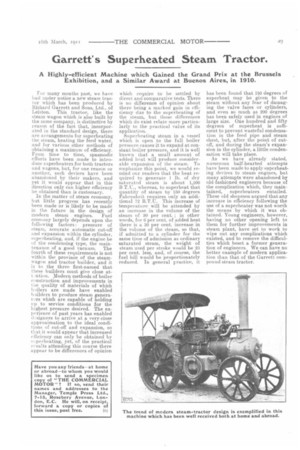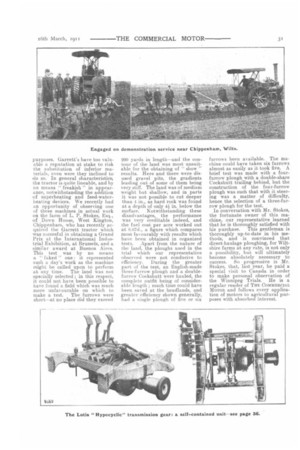Garrett's Superheated Steam Tractor.
Page 5

Page 6

Page 7

If you've noticed an error in this article please click here to report it so we can fix it.
A Highly-efficient Machine which Gained the Grand Prix at the Brussels Exhibition, and a Similar Award at Buenos Aires, in 1910.
For many months past, we have had under notice a new steam tractor which has been produced by Richard Garrett and Sons, Ltd., of Leiston. This tractor, like the steam wagon which is also built by the same company, is distinctive by reason of the fact that, incorporated in the standard design, there are arrangements for superheating the steam, heating the feed water, and for various other methods of obtaining a maximum of efficiency. From time to time, spasmodic efforts have been made to introduce superheaters for both tractors and wagons, but, for one reason or another, such devices have been abandoned by their makers, and yet it would appear that in this direction only can higher efficiency be obtained than is customary.
In the matter of steam economy, but little progress has recently been made or is likely to be made in the future in the design of modern steam engines. Fuel economy largely depends upon the following factors : pressure of steam, accurate automatic cut-off and expansion within the cylinder, superheating, and, if the engine be oi the condensing type, the maintenance of a good vacuum. The fourth of these requirements is not within the province of the steamwagon and tractor builder, and it is to the three first-named that these builders must give close att :ntion. Modern methods of boiler eenstruction and improvements in the quality of materials of which hailers are made have enabled bailders to produce steam generatire which are capable of holding up to service conditions for the highest pressure desired. The experience of past years has enabled (1signers to arrive at a very-close approximation to the ideal conditions of cut-off and expansion, so that it would appear that increased efficiency can only he obtained by s!lperheating, yet, of the practical results attending this course there appear to be differences of opinion
which require to be settled by direct and comparative tests. There is no difference of opinion about there being a marked gain in efficiency due to the superheating of the steam, but those differences which do exist relate more particularly to the practical value of its application.
Superheating steam in a vessel which is open to the full boiler pressure causes it to expand at constant boiler pressure, and it is well known that a small amount of added heat will produce considerable expansion of the steam. To emphasize this point, we would remind our readers that the heat required to generate 1 lb. of dry saturated steam is about 1,200 1.3.T.15., whereas, to superheat that quantity of steam by 150 degrees Fahrenheit requires only an additional 72 B.T.U. This increase of temperature will be attended by an increase in the volume of the steam of 30 per cent. ; in other words, for 6 per cent. of added heat there is a 30 per cent, increase in the volume of the steam, so that, if admitted to a cylinder for the same time of admission as ordinary saturated steam, the weight of steam used per stroke would be 23 per cent. less, and, of course, the fuel bill would be proportionately reduced. In general practice, it has been found that 150 degrees of superheat may be given to the steam without any fear of damaging the valve faces or cylinders, and even so much as 200 degrees has been safely used in engines of large size. One hundred and fifty degrees of superheat is sufficient to prevent wasteful condensation in the feed pipe and steam chest, but, after the point of cutoff, and during the steam's expansion in the cylinder, a little condensation will take place.
As we have already stated, numerous half-hearted attempts have been made to apply superheating devices to steam engines, but many attempts were abandoned by old-fashioned engineers because of the complication which, they maintained, superheaters entailed. These old shopmen argued that any increase in efficiency following the use of a superheater was not worth the means by which it was obtained. Young engineers, however, having no other opening left to them for further improvements in steam plant, have set to work to wipe out any complications which existed, and to remove the difficulties which beset a former generation of engineers. We can have no better example of modern application than that of the Garrett compound steam tractor. Of the Garrett boiler itself, we need say no more than that it is a first-class example of modern practice of the loco. type, the only difference from usual practice being the fitting of a firebox which has a corrugated roof—a type of firebox which has been fitted to all Garrett machines for many years past. This corrugated roof gives both increased heating surface and dispenses with the need for roof stays. Two concentric superheater coils are fitted, partly in the base of the funnel (for which purpose the funnel has an enlarged base) and partly in the smokebox itself ; in one of our illustrations, the outer coil may be seen through the open smokebox door. The outside diameter of the larger coil is about 15 in., whilst that of the inner coil is about in. Both coils are made of solid-drawn steel tube, the bore of which is 1 in. The ends of the coils are expanded into a header that is secured to the rear side of the enlarged funnel base, and this header is connected both to the main steam pipe and the steam chest. All parts of the boiler and superheater are tested by hydraulic pressure (with cold water) to 360 lb, per sq. in., whilst the boiler's regular working pressure is 180 lb. per sq. in. The degree of superheat varies from 100 to 150 degrees, according to the class of coal which is employed.
The engine is of the compound type, both the cylinders and the valve chests being made in one casting with a large saddle base secured to the shell of the boiler. The valves are arranged outside the cylinders, and they are of the balanced piston type, and are operated for forward and reverse running by a couple of eccentrics and a modified form of Stephenson link motion. The cross-head guides are of the usual trunk pattern. The crankshaft is machined all over from a solid forging, and, wherever possible, the fitting of loose keys for gear wheels, etc., has been avoided. Provision is made on the cylinder castings for the fitting of a governor, and, of course, for threshing purposes such a fitment would be necessary. The base on which the governor may be mounted is clearly shown in one of the detail views on this page, which view also shows the position of the feed-water heater that is mounted on the top of the auxiliary water tank. Both an injector and an engine-driven feed pump are fitted, the latter being geared
down so as to prevent its being run at an excessive speed. This pump is fitted inside the horn plates, and is driven by an eccentric off its own countershaft ; its position is very accessible, and the driver may easily remove the valves for adjustment or replacement when necessary. The main water tank is, of course, embodied in the tender, but an auxiliary water tank is fitted as shown, and the combined capacity of the tanks is about 145 gallons.
The transmission is on the threeshaft principle, and the body of the tractor is mounted over the axles by three laminated springs, the two rear ones having provision for adjustment, so that the relative positions of the axle and intermediate shaft may be regulated to a nicety. Three-eighths in. of spring movement is allowed before the axle boxes come to rest in the guide brackets ; this maker maintains that that amount of spring movement is the maximum which may be allowed consistently with freedom from excessive cost for the upkeep for the spring gear.
The whole design of the Garrett tractor is very commendable, and the materials which are employed throughout are the best and most suitable for their respective
purposes. Garrett's have too valuable a reputation at stake to risk the substitution of inferior materials, even were they inclined to do so. In general characteristics; the tractor is quite lineable, and by no means " freakish " in appearance, notwithstanding the addition of superheating and feed-waterheating devices. We recently had an opportunity of observing one of these machines in actual work on the farm of L. P. Stokes, Esq., of Down House, West Kington, Chippenham, who has recently acquired the Garrett tractor which was succesful in obtaining a Grand Prix at the International Industrial Exhibition, at Brussels, and a similar award at Buenos Aires. This test was by no means
" faked" one it represented such a day's work as the machine might be called upon to perform at any time, The land was not specially selected ; in this respect, it could not have been possible to have found a field which was much more unfavourable on which to make a test. The furrows were short—at no place did they exceed
200 yards in length—and the contour of the land was most unsuitable for the obtaining of " show " results. Here and there were disused gravel pits, the gradients leading out of some of them being very stiff. The land was of medium weight but shallow, and in parts it was not possible to cut deeper than 1 in., as hard rock was found at a depth of only 4i in. below the surface. Notwithstanding these disadvantages, the performance was very creditable indeed, and the fuel cost per acre worked out at 8.67d., a figure which compares most favourably with results which have been obtained in organized tests. Apart from the nature of the land, the ploughs used in the trial which our representative observed were not conducive to efficiency. During the greater part of the test, an English-made three-furrow plough and a doublefurrow Cockshutt were hauled, the complete outfit being of considerable length ; much time could have been saved at the headlands, and greater efficiency shown generally, had a single plough of five or six furrows been available.The machine could have taken six furrows almost as easily as it took five. A brief test was made with a fourfurrow plough with a double-share Cockshutt trailing behind, but the construction of the four-furrow plough was such that with it steering was a matter of difficulty, hence the selection of a three-furrow plough for the test. In conversation with Mr. Stokes, the fortunate owner of this machine, our representative learned that he is thoroughly satisfied with his purchase. This gentleman is thoroughly up-to-date in his methods, and is convinced that direct-haulage ploughing, for Wiltshire farms at any rate, is not only a possibility, but will ultimately become absolutely necessary to success. So progressive is Mr. Stokes, that, last year, he paid a special visit to Canada in order to make personal observation of the Winnipeg Trials. He is a regular reader of Tin COMMERCIAL MOTOR and follows every application of motors to agricultural purposes with absorbed interest.






















